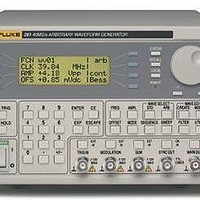FLUKE-284 Fluke, FLUKE-284 Datasheet - Page 2

FLUKE-284
Manufacturer Part Number
FLUKE-284
Description
Function Generators & Synthesizers 4 CHANNEL ARBITRARY 40 MS/S WAVEFORM GEN
Manufacturer
Fluke
Datasheet
1.FLUKE-284.pdf
(8 pages)
Specifications of FLUKE-284
Frequency
1 mHz to 10 MHz
Equipment Type
Waveform Generator
Lead Free Status / Rohs Status
Lead free / RoHS Compliant
Other names
2423199
2
superior performance and excellent value
Pulse generator
Waveform sequencing
Fluke 280 and 290 Series
Universal waveform generators offering
The Fluke 280 Series and
290 Series Waveform
Generators combine a
true variable clock
arbitrary waveform
generator with a high
performance DDS func-
tion generator and pulse
generator in a single
instrument.
Wide model range
The Fluke 280 Series and
290 Series comprise of six models:
•
•
•
•
•
•
channel can be operated fully
independently, or multiple chan-
nels can be linked using simple
or complex relationships.
A true arbitrary generator
The 280 and 290 Series are
highly sophisticated 12-bit
arbitrary waveform generators
capable of recreating virtually
any waveform. True variable
clock architecture is used with
clock speeds between 0.1 Hz and
100 MHz (40 MHz on 280 Series
units). This architecture avoids
281 40 MS/s single-channel
waveform generator in 3U half
rack size case.
282 40 MS/s two-channel
waveform generator in 3U case.
284 40 MS/s four-channel
waveform generator in 3U case.
291 100 MS/s single-channel
waveform generator in 3U half
rack size case.
292 100 MS/s two-channel
waveform generator in 3U case.
294 100 MS/s four-channel
waveform generator in 3U case.
On multi-channel units, each
the clock jitter associated with
DDS arbitrary generators and
permits waveform linking,
looping and sequencing.
with up to 4096 vertical points
and from 8 M to 1 M horizontal
points (4 K to 64 K points on
280 Series units).
replayed at a specified waveform
frequency, period or sample clock
rate. An external sample clock
can also be used on 290 Series
units allowing seamless on the
fly changes to output frequency.
storage is on removable Compact
Flash cards, making waveform
management easy and effectively
unlimited.
Function generator
Each channel can operate as a
full DDS function generator. High
quality sine, cosine, haversine,
havercosine and square waves
are available between 1 mHz and
16 MHz (280 Series) or up to 50
MHz (290 Series). Triangle, ramp
and sine(x)/x waveforms are
available from 0.1 mHz up to
500 kHz.
Pulse generator
Each channel can generate not
just pulses, but also complex
pulse trains. A pattern of up to
10 pulses can be quickly defined,
with each pulse having its own
amplitude, width and delay.
The whole pulse train pattern
can then be replayed at a user
defined repetition rate. Where
variable rise time pulses are
required, the full arbitrary
function can be used.
Waveforms may be defined
Arbitrary waveforms may be
The 290 series waveform
Features
•
•
•
•
•
•
•
•
•
•
•
•
•
•
•
•
1, 2 or 4 waveform channels,
independent or linked
40 MS/s or 100 MS/s 12-bit arbitrary
waveform capability using true
variable clock architecture
64 K or 1 M point waveform memory
per channel
16 MHz or 50 MHz function
generators using direct digital
synthesis (DDS)
Multiple standard waveforms includ-
ing sine, square, triangle, haversine,
ramp, pulse and sin(x)/x
Pulse train pattern generation for up
to 10 pulses
Complex waveform sequencing and
looping capability using up to 1024
waveform segments
Wide range sweep, AM, tone
switching, signal summing
Inter-channel triggering, summing
and phase control
Multiple generators can be easily
phase locked
External ARB clock input
(290 Series only)
Waveform creation/editing tools built
in; sophisticated external Windows
based software included
Built-in trigger generator, gated and
triggered burst modes
Tone switching facilitates precision
DTMF generation
Unlimited waveform storage using CF
memory cards (290 Series only)
GPIB (IEEE-488.2), RS-232 and USB
interfaces (280 Series units have
GPIB and RS-232 only)
40 MS/s or 100 MS/s
one, two or four channels
Waveform creation
and editing
Waveform creation and editing
features are in corporated within
the instrument. These in clude
waveform insert, point edit,
line draw, amplitude adjust and
invert.
waveforms are avail able for
insertion within an arbitrary
waveform. Sections of existing
arbitrary waveforms can also
be inserted. For more sophis-
ticated waveform creation and
editing, Waveform Manager
Plus soft ware for the Windows
operating system is provided.
can be down loaded to the
instrument via the digital inter-
faces (or memory card where
fitted).
Memory card storage
Fluke 290 Series units incorpo-
rate a CompactFlash memory
card, giving effectively unlim-
ited stor age for waveforms and
setups. Waveform data can be
transferred directly from a PC to
the memory card using the USB
card reader/writer supplied.
GPIB, RS-232, USB
The 280 and 290 Series
incorporate both RS-232 and
GPIB (IEEE-488) interfaces as
standard. 290 Series units also
A wide range of standard
Waveforms created on a PC
®
have a USB interface. These can
be used for loading arbitrary
wave forms and for remote
control of all the instru ment
functions.
Waveform sequencing
The variable clock architec-
ture of the 280 and 290 Series
enables waveforms to be
se quenced. Up to 1024 arbitrary
waveforms may be linked in a
sequence (16 waveforms on 280
Series). Each waveform can have
a loop count of up to 32,768 and
the whole sequence can be run
contin uously or re peated more
than a million times.
waveforms on dif ferent channels
can be ‘daisy chained’ and
looped. By summing the channel
outputs, multiple segments from
multiple channels can be used
to create highly complex wave-
forms.
Wide range sweep
All waveforms can be swept
over their full fre quency range
at a rate variable between milli-
seconds and minutes. Sweep
can be linear or logarithmic,
single or continuous. Single
sweeps can be triggered from
the front panel, the trigger input,
or the digital interfaces. Multiple
channels can be swept simulta-
neously.
For multi-channel models,







